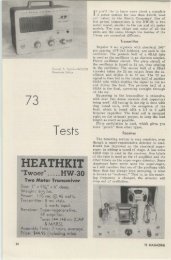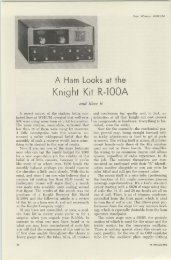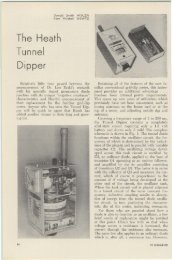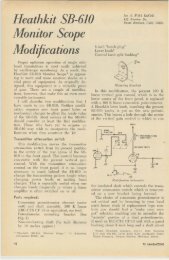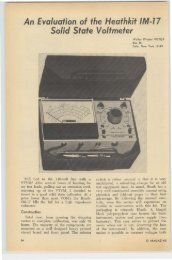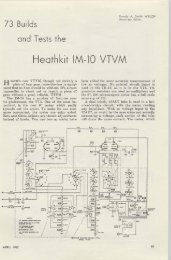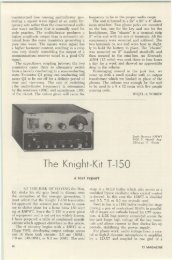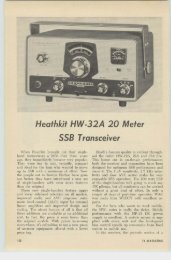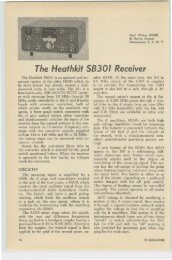The Heathkit SB-401 Transmitter - Nostalgic Kits Central
The Heathkit SB-401 Transmitter - Nostalgic Kits Central
The Heathkit SB-401 Transmitter - Nostalgic Kits Central
You also want an ePaper? Increase the reach of your titles
YUMPU automatically turns print PDFs into web optimized ePapers that Google loves.
In either L<strong>SB</strong> or U<strong>SB</strong> modes, when the<br />
final tubes are driven into grid current, a<br />
voltage appears at the junction of a resistor<br />
and capacitor in the final grid circuit.<br />
This voltage, which follows the audio<br />
peaks. is rectified by a pair of diodes and<br />
appears on the grid of the 6AV6 isolation<br />
amplifier as a bias. Thus, should the finals<br />
be overdriven, gain is reduced immediately<br />
to prevent splatter. In one of its several<br />
switchable positions, the panel meter displays<br />
the ALe voltage. By keeping an eye<br />
cocked at it, drive may be effectively controlled<br />
by holding voice and gain at the<br />
level where the needle stays where it's supposed<br />
to.<br />
<strong>The</strong> meter also reads final grid and plate<br />
current and plate voltage, as well as relative<br />
output and is very useful in tuning up<br />
and operating within the proper parameters.<br />
<strong>The</strong> lineup is completed by a solid state<br />
power supply furnishing 720 volts de under<br />
full load of 250 mA. Lower voltage dc-250<br />
volts-is also provided for other stages, and<br />
there is -170 volts of bias too.<br />
Comparison with the 58400<br />
<strong>The</strong> major difference between the new<br />
rig and its rather young ancestor is «instant<br />
transceive". Owners of the <strong>SB</strong>400 will<br />
recognize the value of this new feature immediately;<br />
you no longer have to open the<br />
cabinet and change the output cable from<br />
the VFO to switch modes. It was never a<br />
hig deal to do so, but there's no doubt that<br />
the convenience is well worth having. So<br />
many <strong>SB</strong>400 owners have home-brewed conversions<br />
that will do the same thing that a<br />
number of articles have already found their<br />
way into the magazines.<br />
At least one unpubUcized<br />
version this writer knows of<br />
(K2UUJ fathered it) was based on the fact<br />
that the heterodyne oscillator is activated<br />
only in the transceive mode. <strong>The</strong> plate voltage<br />
was picked up at a convenient point<br />
to power a relay that performed the actual<br />
switching of cables. Other schemes have<br />
been used successfully.<br />
An added driver coil is an important but<br />
less noticeable improvement which results<br />
in more 10 meter drive. <strong>The</strong> single driver<br />
coil in the <strong>SB</strong>400 was tuned for 28 MHz.<br />
As a result, drive was insufficient in the<br />
upper reaches of the band. Now, with the<br />
extra coil peaked at 29 MHz switched into<br />
the circuit better results are assured.<br />
<strong>The</strong> VFO mixer stage, although still us-<br />
100<br />
ing a 6EW6, has been completely revamped.<br />
Even a casual comparison shows the difference<br />
at once. A 21.1 ~IHz trap is now<br />
included in the circuit. <strong>The</strong>re arc many<br />
minor revamps elsewhere, the mere fact of<br />
their existence is a pretty good indication<br />
that the boys at Benton Harber arc satisfied<br />
with nothing but the ultimate and continue<br />
to improve their product even when<br />
it is already well accepted.<br />
As further evidence of this thinking, the<br />
58<strong>401</strong> has a 680 ohm resistor inserted in<br />
the screen voltage supply to the finals. It<br />
has been added because it reduces the already<br />
acceptable distortion products figure<br />
by 3 to 4 dB more.<br />
Although the <strong>SB</strong>400 was designed to operate<br />
independently or transceive with the<br />
<strong>SB</strong>300 receiver (which it will also do with<br />
the new <strong>SB</strong>301 ), it was sold only as a complete<br />
unit. With the advent of the <strong>SB</strong><strong>401</strong>,<br />
however, Heath has changed their marketing<br />
strategy and made the rig even more<br />
of a bargain for those who own the receiver.<br />
<strong>The</strong> new model is available complete, as<br />
before-which is what you'd need to use<br />
it with any other receiver-but, if you own<br />
either the <strong>SB</strong>300 or <strong>SB</strong>301, you can buy<br />
the transmitter for less without the crystals<br />
which are sold as a separate accessory.<br />
<strong>The</strong> new transmitter's VFO has been modified,<br />
just as it was in the transition from<br />
one receiver to another. Minor circuitry<br />
changes and use of an industrial type 6BZ6<br />
instead of the old 6AU6 is the story. At<br />
the risk of boring those who may have read<br />
the review of the <strong>SB</strong>301, this seems to be<br />
gilding the lily, because the original VFO<br />
was rock steady. <strong>The</strong> new one is<br />
at least<br />
as good, if not better.<br />
Other minor but noticeable changes . . .<br />
a different type of socket on the rear panel<br />
to provide line voltage ac to operate external<br />
relays; the use of two terminal boards<br />
smaller than used in the <strong>SB</strong>400 for below<br />
chassis parts mounting, cleaning things up<br />
nicely.<br />
Construction, alignment and operation<br />
A total of 37); hours was spent building<br />
the transmitter, including about two hours<br />
for photography. Alignment, for which you<br />
need a VTVM with an rf probe, a ham<br />
band or general coverage receiver, and a<br />
dummy load, took about 3 hours more.<br />
Would-be builders may benefit from these<br />
suggestions:<br />
73 MAGAZINE




